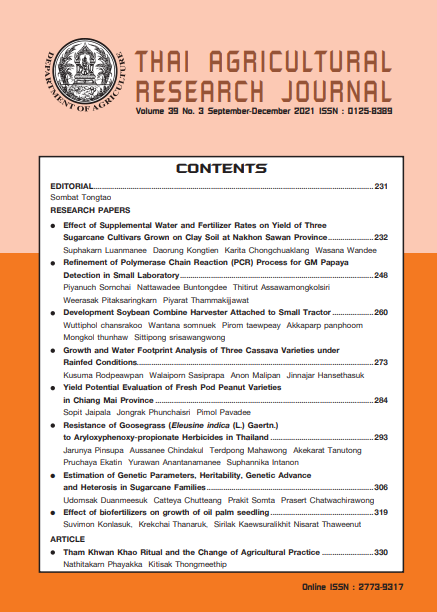Estimation of Genetic Parameters, Heritability, Genetic Advance and Heterosis in Sugarcane Families
DOI:
https://doi.org/10.14456/thaidoa-agres.2021.25Keywords:
Genetic Parameter, Heritability, Genetic Advance, sugarcaneAbstract
The present investigation was to estimate variance components, genetic parameters, broad-sense heritability, genetic advance and heterosis percentage for 9 agronomic traits of 142 bi-parent sugarcane family hybrids and 15 male parents used in this experiment.
The experiments were conducted at three representative locations at Nakhon Pathom (KS), Nakhon Sawan (KL), and Nakhon Ratchasima (KN) from November 2013 to March 2015.
Randomized complete block (RCB) design with 4 replications was employed. Results revealed that the variance components due to families and environments was relatively high, affectinghigherheritability in most agronomictraits, especially the floweringpercentage, stalk
diameter, brix, stalk number, and stalk weight. When considering both broad-sense
heritability and genetic advance, the mean percentage was relatively high in stalk number,
stalk diameter and flowering, which should be highly effective traits for direct selection within these families. There were nine significant family groups based on heterosis percentage for seven traits. Among the offsprings, the male parents had a clear expression pattern
which showed that the FG1 to FG4 came from the TByEFC energy-cane, while the FG5 to
FG9 obtained mainly from sugarcane. The family x trait biplot drawing showed that heterosis percentage on the family group F99 and F102 correlated highly to cane yield and brix yield.
References
Anbanandan, V.and R. Eswaran.2018. Magnitude of heterosis for yield and its components in sugarcane (Saccharum officinarum L.). J. Pharmacogn. Phytochem.1:2671-2674 .
Becker W.A. 1992. Manual of quantitative genetics (5th edn). Pullman, Washington: Academic Enterprises.
Bond, R.S.1977.The mean yield of seedlings as a guide to the selection potential
of sugarcane crosses. Proc. Int. Soc. Sugar Cane Tech. 1977: 101–110.
Deshmukh, S.N., M.S. Basu, and P.S. Reddy. 1986. Genetic variability, character association and path coefficient analysis of quantitative traits in Virginia bunch varieties of groundnut. Indian J. Agric. Sci. 56: 816-821.
Jackson P.A. and T.A. McRae 1998. Gain from selection of broadly adapted and specifically adapted sugarcane families. Field Crops Research. 59: 151-162.
Johnson H.W., H.F. Robinson and R.E. Comstock. 1955. Estimation of genetic and environmental variability in soybeans. Agron. J. 47: 314-318.
Kimbeng C.A. and M.C. Cox. 2003. Early generation selection of sugarcane families and clones in Australia: A Review. Journal American Society of Sugarcane Technologists. 23: 20-39.
Leite, M.S. de.O., L.A. Petermelli, M.H.P. Barbosa, P.R. Cecon and C.D. Cruz.
Sample size for full-sib family evaluation in sugarcane. Pesq. Agropec. Bras., Brasilia. v.44(12):1562-1574.
Mehareb, E.M., Y. Kun, Z. Jun, F.F. Aboelenen, Q. Wei, Z. Fenggang, L. Jiayong, X.
Hongming, Y. Li, Z. Peifang, Z. Yong and W. Caiwen. 2017. Evaluation of seventy six sugarcane families at early selection stages. J. Plant Breed. Crop Sci. 9(9): 151-159.
Pedrozo C.A., M.H.P. Barbosa, F.L.D. Silva, M.D.V. De Resende, L.A. Peternelli. 2001. Repeatability of full-sib sugarcane families across harvests and the efficiency of early selection. Euphytica. 182: 423-430.
Shanthi R.M., K.V. Bhagyalakshmi, G. Hemaprabha, S. Alarmelu and R. Nagarajan 2008. Relative performance of the sugarcane families in early selection stages. Sugar Tech. 10(2): 114-118.
Silva M.A., M.G.A. Landell, P.S. Goncalvea and A.L.M. Martin 2002. Yield component in sugarcane families at four location in the state of Sao Paulo, Brazil. Crop Breeding and Applied Biotechnology. 2(1): 97-106.
Silveira L.C.I., B.P. Brasileiro, V. Kist, H. Weber, E. Daros, L.A. Peternelli, M. Henrique and M.H.P. Barbosa. 2015. Selection strategy in families of energy cane based on biomass production and quality traits. Euphytica. 204: 443-455.
Singh, R. and R.S. Sangwan. 1980. Studies on genetic variability for stalk characters in sugarcane. Ind. Sugar.30:409-412.
Singh, R.K., S.P. Singh and S.B. Singh. 2005. Correlation and path analysis in
sugarcaneratoon. Sugar Tech.7:176-178.
Skinner, J.C., Hogarth, D.M. and Wu, K.K.1987. Selection methods,criteria,and
indices. pp.409–453. In D.J Heinz,ed. Sugarcane Improvement through Breeding.
Elsevier, Amsterdam, Netherlands.
Stringer J.K., M.C. Cox, F.C. Atkin, X. Wei and D.M. Hogarth. 2010. Family selection improves the efficiency and effectiveness of selecting original seedling and parents. Proc. Int. Soc. Sugar Cane Technol. 27: 1-9.
Tang S., R. Yang, L. Wang, B. Zhang, Y. Deng, C. Yang, S. Zhou, W. Xian, F. Tan, H. Tan and L. Yang. 2017. Genetic determination and selection of sugarcane families. Agricultural Science & Technology. 18(1): 5-11.
Zhou M. 2014. Family evaluation for sugarcane yield using data estimated from stalk number, height and diameter. Journal of Crop Improvement. 28: 406-417.
Zhou M. and M. Lichakane. 2020. Family selection gains for quality traits
among South African sugarcane breeding population. S. Afri. J. Plant Soil. 29(3&4): 143-149.
Zhou M., M. Lichakane and S.V. Joshi. 2012. Family evaluation for quality traits in South African sugarcane breeding programmes. Proc. S Afr Sug Technol Ass. 85: 221-231.
Downloads
Published
How to Cite
Issue
Section
License
Copyright (c) 2021 Thai Agricultural Research Journal

This work is licensed under a Creative Commons Attribution-NonCommercial-NoDerivatives 4.0 International License.
Thai Agricultural Research Journal



